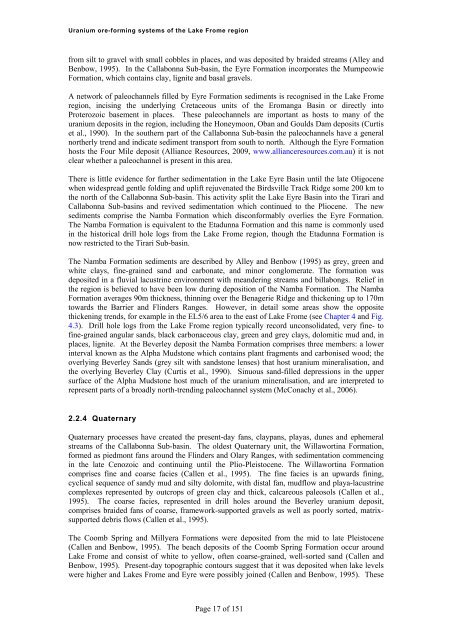Uranium ore-forming systems of the - Geoscience Australia
Uranium ore-forming systems of the - Geoscience Australia
Uranium ore-forming systems of the - Geoscience Australia
You also want an ePaper? Increase the reach of your titles
YUMPU automatically turns print PDFs into web optimized ePapers that Google loves.
<strong>Uranium</strong> <strong>ore</strong>-<strong>forming</strong> <strong>systems</strong> <strong>of</strong> <strong>the</strong> Lake Frome regionfrom silt to gravel with small cobbles in places, and was deposited by braided streams (Alley andBenbow, 1995). In <strong>the</strong> Callabonna Sub-basin, <strong>the</strong> Eyre Formation incorporates <strong>the</strong> MurnpeowieFormation, which contains clay, lignite and basal gravels.A network <strong>of</strong> paleochannels filled by Eyre Formation sediments is recognised in <strong>the</strong> Lake Fromeregion, incising <strong>the</strong> underlying Cretaceous units <strong>of</strong> <strong>the</strong> Eromanga Basin or directly intoProterozoic basement in places. These paleochannels are important as hosts to many <strong>of</strong> <strong>the</strong>uranium deposits in <strong>the</strong> region, including <strong>the</strong> Honeymoon, Oban and Goulds Dam deposits (Curtiset al., 1990). In <strong>the</strong> sou<strong>the</strong>rn part <strong>of</strong> <strong>the</strong> Callabonna Sub-basin <strong>the</strong> paleochannels have a generalnor<strong>the</strong>rly trend and indicate sediment transport from south to north. Although <strong>the</strong> Eyre Formationhosts <strong>the</strong> Four Mile deposit (Alliance Resources, 2009, www.allianceresources.com.au) it is notclear whe<strong>the</strong>r a paleochannel is present in this area.There is little evidence for fur<strong>the</strong>r sedimentation in <strong>the</strong> Lake Eyre Basin until <strong>the</strong> late Oligocenewhen widespread gentle folding and uplift rejuvenated <strong>the</strong> Birdsville Track Ridge some 200 km to<strong>the</strong> north <strong>of</strong> <strong>the</strong> Callabonna Sub-basin. This activity split <strong>the</strong> Lake Eyre Basin into <strong>the</strong> Tirari andCallabonna Sub-basins and revived sedimentation which continued to <strong>the</strong> Pliocene. The newsediments comprise <strong>the</strong> Namba Formation which disconformably overlies <strong>the</strong> Eyre Formation.The Namba Formation is equivalent to <strong>the</strong> Etadunna Formation and this name is commonly usedin <strong>the</strong> historical drill hole logs from <strong>the</strong> Lake Frome region, though <strong>the</strong> Etadunna Formation isnow restricted to <strong>the</strong> Tirari Sub-basin.The Namba Formation sediments are described by Alley and Benbow (1995) as grey, green andwhite clays, fine-grained sand and carbonate, and minor conglomerate. The formation wasdeposited in a fluvial lacustrine environment with meandering streams and billabongs. Relief in<strong>the</strong> region is believed to have been low during deposition <strong>of</strong> <strong>the</strong> Namba Formation. The NambaFormation averages 90m thickness, thinning over <strong>the</strong> Benagerie Ridge and thickening up to 170mtowards <strong>the</strong> Barrier and Flinders Ranges. However, in detail some areas show <strong>the</strong> oppositethickening trends, for example in <strong>the</strong> EL5/6 area to <strong>the</strong> east <strong>of</strong> Lake Frome (see Chapter 4 and Fig.4.3). Drill hole logs from <strong>the</strong> Lake Frome region typically record unconsolidated, very fine- t<strong>of</strong>ine-grained angular sands, black carbonaceous clay, green and grey clays, dolomitic mud and, inplaces, lignite. At <strong>the</strong> Beverley deposit <strong>the</strong> Namba Formation comprises three members: a lowerinterval known as <strong>the</strong> Alpha Mudstone which contains plant fragments and carbonised wood; <strong>the</strong>overlying Beverley Sands (grey silt with sandstone lenses) that host uranium mineralisation, and<strong>the</strong> overlying Beverley Clay (Curtis et al., 1990). Sinuous sand-filled depressions in <strong>the</strong> uppersurface <strong>of</strong> <strong>the</strong> Alpha Mudstone host much <strong>of</strong> <strong>the</strong> uranium mineralisation, and are interpreted t<strong>ore</strong>present parts <strong>of</strong> a broadly north-trending paleochannel system (McConachy et al., 2006).2.2.4 QuaternaryQuaternary processes have created <strong>the</strong> present-day fans, claypans, playas, dunes and ephemeralstreams <strong>of</strong> <strong>the</strong> Callabonna Sub-basin. The oldest Quaternary unit, <strong>the</strong> Willawortina Formation,formed as piedmont fans around <strong>the</strong> Flinders and Olary Ranges, with sedimentation commencingin <strong>the</strong> late Cenozoic and continuing until <strong>the</strong> Plio-Pleistocene. The Willawortina Formationcomprises fine and coarse facies (Callen et al., 1995). The fine facies is an upwards fining,cyclical sequence <strong>of</strong> sandy mud and silty dolomite, with distal fan, mudflow and playa-lacustrinecomplexes represented by outcrops <strong>of</strong> green clay and thick, calcareous paleosols (Callen et al.,1995). The coarse facies, represented in drill holes around <strong>the</strong> Beverley uranium deposit,comprises braided fans <strong>of</strong> coarse, framework-supported gravels as well as poorly sorted, matrixsupporteddebris flows (Callen et al., 1995).The Coomb Spring and Millyera Formations were deposited from <strong>the</strong> mid to late Pleistocene(Callen and Benbow, 1995). The beach deposits <strong>of</strong> <strong>the</strong> Coomb Spring Formation occur aroundLake Frome and consist <strong>of</strong> white to yellow, <strong>of</strong>ten coarse-grained, well-sorted sand (Callen andBenbow, 1995). Present-day topographic contours suggest that it was deposited when lake levelswere higher and Lakes Frome and Eyre were possibly joined (Callen and Benbow, 1995). ThesePage 17 <strong>of</strong> 151
















